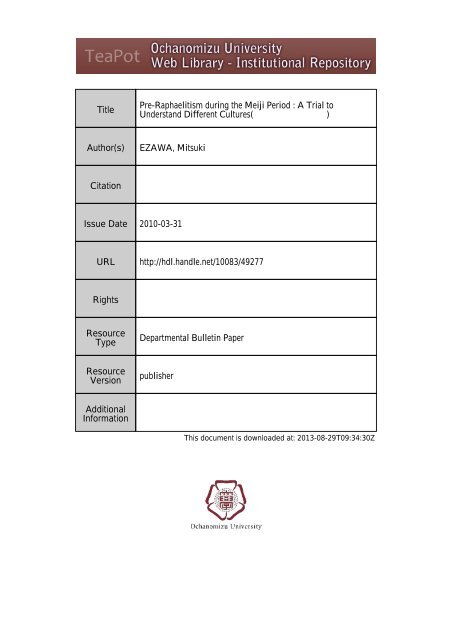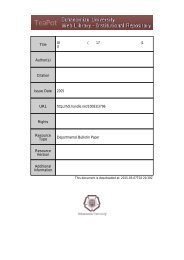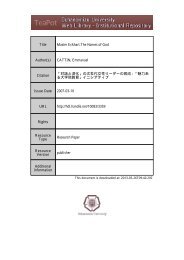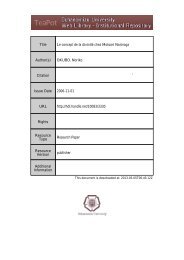View! - TeaPot - お茶の水女子大学
View! - TeaPot - お茶の水女子大学
View! - TeaPot - お茶の水女子大学
You also want an ePaper? Increase the reach of your titles
YUMPU automatically turns print PDFs into web optimized ePapers that Google loves.
TitlePre-Raphaelitism during theUnderstand Different Cultures(イギリス Meiji P共Author(s) EZAWA, MitsukiCitation大 学 院 教 育 改 革 支 援 プログラム「 日 本 文 化 研 究 の 国 際 的情 報 伝 達 スキルの 育 成 」 活 動 報 告 書Issue Date 2010-03-31URLhttp://hdl.handle.net/10083/49277RightsResourceTypeDepartmental Bulletin PaperResourceVersionpublisherAdditionalInformationThis document is downloaded at: 2013
EZAWA, Mitsuki:Pre-Raphaelitism during the Meiji Periodment. According to the historical data in 1870,the foreign experts from Britain were 119, andsurpassed the 50 from France and 16 from theUnited States. 4These governmental supports made Japaneseintellectuals aware of British culture, and someintellectuals began to publish articles in journals tomeet readers’ demand. Among a series of literaryworks they introduced, there was Poems (1870) byDante Gabriel Rossetti who is known today asone of the founding members of Pre-RaphaeliteBrotherhood. Since Rossetti was also a painter, alarge number of his works were introduced in ashort time, and the vogue for Rossetti appearedfrom the early 1890s to the early 1900s. 5 In this era,Japan won the Sino-Japanese War (1894-95/M27-8)after the establishment of the constitution (1889/M22), 6and then achieved its long-sought goal of treatyrevision (1894/M27). At the same time, the Russianmove to expand hegemony to the East Asia becamenoticeable both for Great Britain and Japan, andit led to an alliance between these two empires(1902/M35).This study based on the assumption that the policyof Empire, that is, the policy of colonialism wasgenerated through the incorporation of others’cultures. If so, to investigate the evaluation ofRossetti/Pre-Raphaelitism may have some meaningto it.Ch. 2 Rossetti / Pre-Raphaelitism and the BritishEmpireBefore discussing the introduction of Rossettiinto Japan, it is necessary to investigate the criticalcondition of Rossetti in England. In this study, Iregard Rossetti as a center of Pre-Raphaelitismand examine the three stages of his activities. Thecommon feature of these stages is a sympatheticfeeling to the past, especially in his case, medievalage in Italy. Such a past was not only distant butalso different and unfamiliar for most people underthe British Empire.In 1848, at the first stage of Pre-Raphaelitism,Rossetti founded the Pre-Raphaelite Brotherhoodwith John Everett Millais (1829-96) and WilliamHolman Hunt (1827-1910), and executed paintingswhich conjured up reminiscences of the past andforeign, that is, medieval Italy. However, their revivalof a painting style before Raphael (1483-1520) wasregarded as a challenge to the Raphaelesque paintingstyle in the Victorian Royal Academy. As forRossetti’s paintings at this stage, there is The Girlhoodof Mary Virgin (1848-49) which bears theP.R.B. initials in public for the first time, and itssequence, Ecce Ancilla Domini! (1849-50). It isimportant that the latter picture was criticized notonly for its methodical crudeness but also for itsrelation to the pope, 7 as if it reflected a Britishantipathy to the pope Pius IX (1792-1878). 8 Thetrue reason is not known yet, however, many scholarspointed out Rossetti that refrained fromexhibiting his paintings after this. Instead, helaunched the issue of the Pre-Raphaelite Journalthe title of which was The Germ. It was publishedon the first of January in 1850.Although The Germ was a very short livedperiodical, after this, in 1856, Rossetti began tocontribute to The Oxford and Cambridge Magazinewith William Morris (1834-96) and EdwardBurne-Jones (1833-98). It happened 3 years afterMillais’ election as Associate of the Royal Academyof Art. Therefore, The Oxford and Cambridge Magazinewas a turning point for Rossetti to start newstage activities.In this second stage, Rossetti tried a kind of“translation” of literature both in pictorial andpoetical form. First, as an example of a pictorial“translation,” there is an illustration of “Palace ofArt” which was composed by Alfred Tennyson(1809-92). Until this time, Tennyson had beenalready an honorable Poet Laureate, and his poemwas, in a sense, the representative of the Victorianaesthetics. It is this Tennyson whom Rossetti madepuzzled by his interpretation, 9 since Rossetti empathizedphysical intimacy between St.Cecily and anangel which remained suggestive in its original.A similar interpretive “translation” is also admittedin his poetical “translation.” In 1861, Rossettipublished his translated volume, The Early ItalianPoets, and its overflowing concept was, as its cancelledillustration suggests, love. This volume alsoincluded his translation of Dante’s La Vita Nuova,which dealt Dante’s desperate love for Beatrice.Like his pictorial “translation,” Rossetti gave priorityto the literary effect, and he sometimes paraphrasedthe original rather than literality in hispoetical “translation.” 10 Although some critics regardedthe expression of this volume as erotic,most of them highly appreciated it since it was thefirst translation of early Italian poems in VictorianEngland. 11In this way, Pre-Raphaelitism at the secondstage seemed to be accepted in the British Empire.However, this only depended on its translated form.This fact came to be clear, when Rossetti attemptedto revive the past foreign aesthetics in his own182
EZAWA, Mitsuki:Pre-Raphaelitism during the Meiji PeriodDo cultivate your aesthetic taste and makeJapanese tradition develop to a much higherlevel than Heian-Genroku culture in Japan, ormuch higher than the Elizabethan Culture inEngland, or the Medici Culture in Italy. (vol. 3p.49, Underline original, Translation mine)As was clarified by his response to Buchanan criticism,Ueda’s view did not remain as an expressionof nostalgic feeling, nor xenophobic feeling, either.Rather than these, Ueda wished his renaissance toinfluence the artistic development of his country,and what his renaissance expected was the fusionof currently imported foreign culture with traditionalJapanese culture.Then, how did Ueda perform his renaissancepractically? First, he proclaimed the existence ofPre-Raphaelitism in public by the initials P.R.B. asRossetti did in The Girlhood of Mary Virgin in hisfirst stage. In the front page of Ueda’s first translationvolume Miotsukushi (1901/M34), there is adedication as follows:For our memory of the days when we talkedabout P.R.B.,I dedicated this book to my friend TokubokuHirata.How well I remember the days!(vol.2, Translation mine)The title word, Miotsukushi connotes a desperatelove, which Rossetti likes to express, and theliterary source of the word, “miotsukushi” can betraced back to medieval literature, such as TheTale of Genji. 17 And in Miotsukushi, Ueda includedtranslated foreign love stories and his original loveshort story. All of them are written using oldJapanese usage. Therefore, Miotsukushi seems tobe a practice of Ueda’s renaissance.Next, as for Pre-Raphaelite Journal, it should beremembered the existence of the Geien (1902/M35).This journal was edited by Ueda himself after hisdeclaration of P.R.B. Ueda started the memorialfirst number with the appreciation of Rossetti’sEcce Ancilla Domini! In this same number, Hirataalso emphasized the artistic effect of Rossetti’sSt.Ceicily.Finally, as his Pre-Raphaelite achievement,Ueda published his translated volume Kaichoon(The Sound of Sea) in 1905 (M38). This volumeseems to have three significant meanings. First, asUeda makes clear in the preface, this volumefollows Rossetti’s translating method, and exploresaesthetic effects (vol. 1, p.28). Second, in order tofind more suitable expressions, this volume usesthe old Japanese language. Third, this volumecollects three love poems by Rossetti, one poem byDante, and five poems by Baudelaire as if hechallenges Buchanan criticism.However, it was this time that Pre-Raphaelitismin Japan experienced the vicissitudes of the criticism.Kaichoon was published under the martiallaw at the Russo-Japanese War (1904-5), and firstit was appreciated in the Imperial Literature.However, after this number of this volume, thejournal was prohibited from sale, 18 things completelychanged. As if corresponding to a trend forwar worship literature, this aesthetic work wasironically judged militaristic, and forced to be incorporatedinto the literature. As for Ueda’s effort toadopt the old Japanese usage, it was pointed outthat its genteel expressions were unsuitable for theFrench erotic poems such as the poems by Baudelaire,and as if fighting against Ueda’s associationof French culture with the past Japanese culture,the critic emphasized the differences of Japan’spast, with French culture, and insisted on presentJapanese moral superiorities just like Buchanan’s“Fleshly School” criticism. 19Again Ueda tried to raise a challenge againstthis mono-centric nationalistic trend. From Januaryto March in 1910, Ueda contributed his lovenovel, Uzumaki to the newspaper, Kokumin-shinbunn,and published it as a volume in June in the sameyear. The title Uzumaki means “scroll” in Englishand it was one of the last two possible titles togetherwith The Germ. 20 However, Ueda’s Pre-Raphaelitenovel was not understood at all at that time. Notonly by his critics but also by his sympathizers itwas regarded as a failure. 21 It was the same yearthe Great Treason Incident (1910) happened, andin May of this year, Kotoku Shusui (1871-1911),the socialist who opposed the Russo-JapaneseWar (1904-5), was arrested without the proof onsuspicion of the attempt to assassinate the Meijiemperor. This rash action by the governmentsilenced left-wing activists, and in August Japanannexed Korea, and arose as an Empire.* * *In this article, I have proposed that Pre-Raphaelitismis a representation of cultural diversity. DanteGabriel Rossetti, the epicenter of Pre-Raphaelitism,tried to revive the medieval Italian aesthetics inVictorian era. Rossetti’s activities enhanced thecultural diversity in England, and this diversityconflicted with the mono-centric nationalism of the184
イギリス 共 同 ゼミBritish Empire advocated by Robert Buchanan.Ueda Bin, a prominent introducer of Rossettiinto Japan, had well known how the controversiesbetween the Pre-Raphaelites and the opposites inEngland were provoked. The revival of the pastaesthetics by Rossetti was so influential for Uedathat he recognized the revival of the Heian-Edoaesthetics as a representation of the cultural diversityin Japan. When the mono-centric nationalismof the Meiji Empire was rampant, Ueda would beblamed for his renaissance movement, in the sameway as Rossetti had been criticized. In my doctoraldissertation, more details will be investigated forthe political impact of Pre-Raphaelitism on Japaneseculture in the Meiji era.NotesI have attempted a slight revision of this paper, spoken atSOAS/Ochanomizu University Joint Faculty and GraduateStudent Seminar on 19 March, 2009.1 For an earlier version of this study, see, Ezawa Mitsuki“Meiji Jidai no Raphael Zenpa Shyugi: D.G. Rossetti noShishyu Juyo no Haikei (Pre-Raphaelitism during theMeiji Period: the Background of the Introduction of D.G.Rossetti’s Poems)” in Politics of Cultural Representations:Reassessment of Histories of Women in Japan &Korea (Tokyo: Project D: Theories and Representations“Frontiers of Gender Studies” (F-GENS) 21 st CenturyCOE Program Ochanomizu University, 2007) 36-43.2 Nihon no Eigaku 100 nen Henshubu ed. Nihon noEigaku 100 nen Meiji hen (Tokyo: Kenkyusya 1968) 5.3 Andrew Cobbing, The Japanese Discovery of VictorianBritain (Richmond: Japan Library, 1998) 30.4 Nihon no Eigaku 100 nen Hensyubu ed. (see note 2)22-23.5 For the previous studies of the introduction of Rossetti,see the references of my earlier study (cf. note 1).6 The abbreviations in the subsequent parentheses inthis paper are as follows: M indicates Meiji. T meansTaisho, and S is Showa.7 William Michael Rossetti, Dante Gabriel Rossetti: HisFamily-Letters. Vol.1 (Elibron Classics, 2006) 161.8 Cf. Denis Mack Smith, “Britain and the ItalianRisorgimento” Britain and Italy from Romanticism toModernism, ed. Martin McLaughlin (Oxford: Legnda,2000), 13-31.9 Cf. Bethan Stevens, The British Museum Pre-Raphaelites(London: British Museum P, 2008) 48-49.10 Cf. D.G. Rossetti, “Preface” The Early Italian Poets(London: Smith, Elder, 1861) viii.11 Ezawa Mitsuki, “19 seiki oyobi Gendai Igirisu ni okeruRaphael Zenpa no Hyoka to Teikokushyugi (Reassessment ofPre-Raphaelitism and Nationalism)” Developing InternationalCommunication Skills in Japanese Cultural Studies (Tokyo:Ochanomizu U, 2008) 67-71.12 Cf. Thomas Maitland, “The Fleshly School of Poetry:Mr. D.G. Rossetti” Contemporary Review 18 (1871):334-50, Robert Buchanan, The fleshly School of poetryand Other phenomena of the day. (London: Strahan,1872).13 In Japanese, the family name is followed by the givenname. I will follow this pattern in this paper.14 The volume numbers attached to the subsequentcitations depend on the following volumes: Teihon UedaBin Zenshyu (Tokyo: Kyoikutosho Center, 1979).15 [Ueda Bin], Teikoku Bungaku Vol.2 no.5 (1896): 111-13.This article came to be included as an supplement in“Rossetti no Shihen (The Poetry of Rossetti)” BungeiRonshyu in 1901. Cf. Teihon Ueda Bin Zenshyu vol.3(Tokyo: Kyoikutosho Center, 1979) 225-229.16 Ezawa (2007) 38 , n.8.17 Shimada Kinji, “Kaisetsu” Teihon Ueda Bin Zenshyuvol.2 (Tokyo: Kyoikutosho Center, 1979) 613-14.18 Ezawa (2007) 40, n.12.19 Ibid. 40, n.17.20 William Michael Rossetti, 152.21 Yasuda Yasuo Uedabin Kenkyu (Tokyo: Yusei-do,1969) 250.ReferencesBeasley, W.G. Great Britain and the Opening of Japan1834-1858. Folkestone: Japan Library, 1995.Gordon, Andrew, A Modern History of Japan. New York:Oxford UP, 2003.Treuhertz, Julian, Elizabeth Prettejohn and EdwinBecker, Dante Gabriel Rossetti. London: Thames &Hudson, 2003.えざわ みつき/お 茶 の 水 女 子 大 学 大 学 院 人 間 文 化 研 究 科 比 較 社 会 文 化 学 専 攻185






